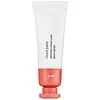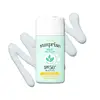What's inside
What's inside
 Key Ingredients
Key Ingredients

 Benefits
Benefits

 Concerns
Concerns

 Ingredients Side-by-side
Ingredients Side-by-side

Water
Skin ConditioningCyclopentasiloxane
EmollientMethyl Trimethicone
Skin ConditioningButylene Glycol
HumectantPEG-10 Dimethicone
Skin ConditioningMica
Cosmetic ColorantDicaprylyl Carbonate
EmollientNeopentyl Glycol Diheptanoate
EmollientDisteardimonium Hectorite
StabilisingGlycerin
HumectantVinyl Dimethicone/Methicone Silsesquioxane Crosspolymer
Sorbitan Isostearate
EmulsifyingSoluble Collagen
HumectantEthylhexylglycerin
Skin ConditioningMagnesium Sulfate
Dimethicone/Vinyl Dimethicone Crosspolymer
Skin ConditioningMethyl Methacrylate Crosspolymer
Triethoxycaprylylsilane
Disodium EDTA
Polyglyceryl-2 Triisostearate
EmulsifyingPentylene Glycol
Skin ConditioningPhenoxyethanol
PreservativeSilica
AbrasiveAluminum Hydroxide
EmollientTin Oxide
AbrasiveCI 77891
Cosmetic ColorantIron Oxides
CI 75470
Cosmetic ColorantCI 73360
Cosmetic ColorantCI 15985
Cosmetic ColorantWater, Cyclopentasiloxane, Methyl Trimethicone, Butylene Glycol, PEG-10 Dimethicone, Mica, Dicaprylyl Carbonate, Neopentyl Glycol Diheptanoate, Disteardimonium Hectorite, Glycerin, Vinyl Dimethicone/Methicone Silsesquioxane Crosspolymer, Sorbitan Isostearate, Soluble Collagen, Ethylhexylglycerin, Magnesium Sulfate, Dimethicone/Vinyl Dimethicone Crosspolymer, Methyl Methacrylate Crosspolymer, Triethoxycaprylylsilane, Disodium EDTA, Polyglyceryl-2 Triisostearate, Pentylene Glycol, Phenoxyethanol, Silica, Aluminum Hydroxide, Tin Oxide, CI 77891, Iron Oxides, CI 75470, CI 73360, CI 15985
Water
Skin ConditioningZinc Oxide
Cosmetic ColorantDisiloxane
Skin ConditioningCyclohexasiloxane
EmollientButyloctyl Salicylate
Skin ConditioningPropylene Glycol Dicaprylate
EmollientPropanediol
SolventMethyl Trimethicone
Skin ConditioningMethyl Methacrylate Crosspolymer
Triethoxycaprylylsilane
Lauryl Polyglyceryl-3 Polydimethylsiloxyethyl Dimethicone
Skin ConditioningSodium Chloride
Masking1,2-Hexanediol
Skin ConditioningPolymethylsilsesquioxane
Polyglyceryl-3 Polydimethylsiloxyethyl Dimethicone
Skin ConditioningParfum
MaskingCaprylyl Glycol
EmollientGlyceryl Caprylate
EmollientEthylhexylglycerin
Skin ConditioningSodium Hyaluronate
HumectantHelianthus Annuus Seed Oil
EmollientAdansonia Digitata Seed Oil
EmollientButylene Glycol
HumectantTocopherol
AntioxidantOpuntia Ficus-Indica Extract
Skin ConditioningPhenoxyethanol
PreservativeAloe Barbadensis Leaf Juice
Skin ConditioningCitric Acid
BufferingPotassium Sorbate
PreservativeCarex Humillis Root Extract
Skin ConditioningSodium Benzoate
MaskingMalpighia Emarginata Fruit Extract
Skin ConditioningEuterpe Oleracea Fruit Extract
Terminalia Ferdinandiana Fruit Extract
AntioxidantWater, Zinc Oxide, Disiloxane, Cyclohexasiloxane, Butyloctyl Salicylate, Propylene Glycol Dicaprylate, Propanediol, Methyl Trimethicone, Methyl Methacrylate Crosspolymer, Triethoxycaprylylsilane, Lauryl Polyglyceryl-3 Polydimethylsiloxyethyl Dimethicone, Sodium Chloride, 1,2-Hexanediol, Polymethylsilsesquioxane, Polyglyceryl-3 Polydimethylsiloxyethyl Dimethicone, Parfum, Caprylyl Glycol, Glyceryl Caprylate, Ethylhexylglycerin, Sodium Hyaluronate, Helianthus Annuus Seed Oil, Adansonia Digitata Seed Oil, Butylene Glycol, Tocopherol, Opuntia Ficus-Indica Extract, Phenoxyethanol, Aloe Barbadensis Leaf Juice, Citric Acid, Potassium Sorbate, Carex Humillis Root Extract, Sodium Benzoate, Malpighia Emarginata Fruit Extract, Euterpe Oleracea Fruit Extract, Terminalia Ferdinandiana Fruit Extract
 Reviews
Reviews

Ingredients Explained
These ingredients are found in both products.
Ingredients higher up in an ingredient list are typically present in a larger amount.
Butylene Glycol (or BG) is used within cosmetic products for a few different reasons:
Overall, Butylene Glycol is a safe and well-rounded ingredient that works well with other ingredients.
Though this ingredient works well with most skin types, some people with sensitive skin may experience a reaction such as allergic rashes, closed comedones, or itchiness.
Learn more about Butylene GlycolEthylhexylglycerin (we can't pronounce this either) is commonly used as a preservative and skin softener. It is derived from glyceryl.
You might see Ethylhexylglycerin often paired with other preservatives such as phenoxyethanol. Ethylhexylglycerin has been found to increase the effectiveness of these other preservatives.
This ingredient comes as a powder made up of small, porous, microbeads. It is used to add a silky feel to products and also helps absorb oil.
Methyl Trimethicone is a type of silicone. It is a solvent and emulsifier.
Solvents are used to keep ingredients together in a product. They can help dissolve ingredients to stable bases or help evenly distribute ingredients throughout the product.
Emulsifiers help stabilize a product. It does this by preventing certain ingredients from separating.
Methyl Trimethicone does not get absorbed into the skin.
Learn more about Methyl TrimethiconePhenoxyethanol is a preservative that has germicide, antimicrobial, and aromatic properties. Studies show that phenoxyethanol can prevent microbial growth. By itself, it has a scent that is similar to that of a rose.
It's often used in formulations along with Caprylyl Glycol to preserve the shelf life of products.
Triethoxycaprylylsilane is a silicone used to bind and stabilize ingredients.
As an emulsifier, it helps prevent ingredients from separating. This can help elongate the shelf life of products.
Triethoxycaprylylsilane is often used to coat mineral sunscreens ingredients to help give a better feel. It also helps reduce oxidative stress in sunscreens.
Learn more about TriethoxycaprylylsilaneWater. It's the most common cosmetic ingredient of all. You'll usually see it at the top of ingredient lists, meaning that it makes up the largest part of the product.
So why is it so popular? Water most often acts as a solvent - this means that it helps dissolve other ingredients into the formulation.
You'll also recognize water as that liquid we all need to stay alive. If you see this, drink a glass of water. Stay hydrated!
Learn more about Water